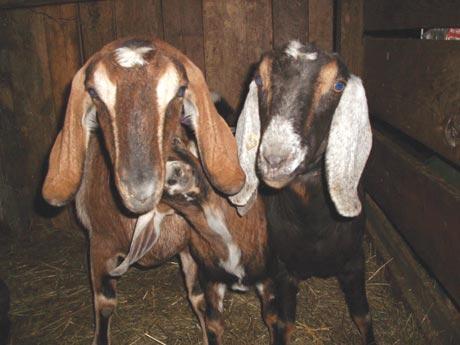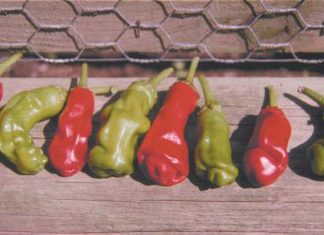| By Tanya Kelley | |
| Issue #128 • March/April, 2011 |
If you milk goats, there’s no doubt you’ve heard it”Eww! Goat’s milk! Gross!” To be perfectly honest, goat milk does taste different than cow milk. So? Different doesn’t necessarily mean bad.
True, goat milk can taste downright “goaty.” Goaty enough that even my dog wrinkles his nose at it. There are steps you can take to keep your milk sweet and delicious. There are also ways to break your family into the idea that goat milk might just be the best thing since sliced bread.
So, why not just get a cow and avoid all the family drama? First of all, a cow is a much bigger animal. Yes, they put out a lot more milk, but if your cow dies (and they do, believe me) you are out of milk. When your cow is late in pregnancy or has just freshened, you are out of milk.
The expense and space required for one cow can keep a lot of goats. If a goat dies, you’ll likely have more than one. You can stagger breedings to keep a year-round supply of milk.
The goat is often called the poor man’s cow. Cow milk may be the norm in the United States, but across the world, goat’s milk is more common.
So how do you get your family to like goat milk? For my family, it was a tough sell. I hated dumping a gallon and a half of rich goat milk to feed pigs and chickens, only to spend $3 a gallon at our local shopping center for cow’s milk on an almost daily basis.
|
Keeping goat milk delicious
I attacked the problem from two directions. First, I had to make sure the milk never acquired that unpleasant goaty flavor.
Prevention starts with your goat. Remember, what goes in must come out. Good quality feed, water, and minerals are mandatory. I have heard some say that mineral deficiencies can cause off-tasting milk, but I have not personally experienced that. Goats that browse on wild onions, various mints, and garlic are also prone to unpleasantly-flavored milk.
|
If you’ve even been around a buck goat in rut, you’ll have no trouble believing his musk could affect the flavor of milk from any does around him; however, that isn’t always the case. I was shocked when I went into the barn at a large, commercial goat dairy near me. There were several bucks in rut hanging out in the same pens as the does. I asked the owner about buckiness in the milk and she said it had never been a problem. Since then, I have kept my buck with my does and found the same; however, my buck is still young. It might be a case-by-case situation.
Once your goat care is in place, prepare for milking. A clean milk pail is a must, as is a seamless stainless steel or glass container. Plastic absorbs flavors from the milk and will go from barely noticeable to downright goaty in a matter of days. Containers with seams have the same problemyou can’t get them completely clean.
Many people milk into the pail and then strain the milk after, but if you think about it, milking can be dirty business. Your bucket of milk is sitting under an animal that has been lying around in straw, probably manure, and who knows what else. Add the natural sloughing off of skin and hair and it gets gross. I don’t want that stuff floating in my milk, even for a little while. I strain while I milk. I know there are many options for milk pail strainers, but I made my own. I cut a circular hole out of a plastic lid from some long-lost mixing bowl. The lid fits onto my stainless steel milk pail and I can drop a fine-screened coffee filter into the cut out circle. The milk shoots through the screen and debris stays out. Later, I filter the milk again, just in case.
The faster you chill your milk, the better it will taste, especially during warm weather. I keep some lunch box-sized Blue Ice blocks in my freezer, and drop two into the milk pail before milking. The milk is chilled as soon as it hits the Blue Ice. After I milk, I wash the blocks off and pop them back into the freezer. They will be frozen again by the next milking.
|
The milk pail screen stops most debris from getting in the milk, but eliminating debris before it falls is even better. I use a cheap pair of people hair clippers to trim the hairs on the goat’s udder. That eliminates any “dirt catchers.” A trim every few weeks will be sufficient.
Once the udder is clipped, wash it with warm water before each milking. Dry it with a clean towel (use a fresh one every time you milk). Small, inexpensive washcloths work great for washing and drying and they are easy to launder. You can use unscented baby wipes too. Not only does washing the doe’s udder prevent contamination of your milk, it also helps prevent bacteria from causing problems with your goat’s udder. Wash your own hands, too.
Put a couple of squirts of milk into a test cup to check for any thickened milk, clots, or bloodwarning signs that all might not be well. Not only will these affect the taste of your milk but also your doe’s health. If everything looks good, milk the doe out.
After you milk, dip your goat’s teats into a teat dip to further protect the udder from bacteria. There are many teat dip products you can buy, and you can even make your own.
Once you get your milk in the house, you may want to pasteurize it. There is a lot of debate about pasteurized milk vs. raw milk. You’ll have to research and decide that for yourself. I don’t find that pasteurizing prevents off tastes in my milk.
|
Put your fresh milk in the refrigerator as soon as you can. Store it in seamless glass or stainless steel containers. You can sterilize the containers if you like, but I’ve had good luck with jars that have been washed in warm soapy water and rinsed clean. Your container must have a tight fitting lid or your milk will absorb flavors from the refrigerator.
Your milk should taste fresh and delicious for several days or more. After a day or so you’ll find cream on the top. You can skim it to use or shake the milk to mix it back in. Remember, this isn’t store-bought, homogenized milk. It’s the real thing.
Getting used to the taste
Is your family still stuck in the “different is bad” cycle? If your milk doesn’t taste goaty, they may be unfamiliar with the fresh dairy taste. Even fresh cow’s milk has that taste.
|
One way to get past that is to gradually introduce goat milk. Try mixing a cup of it into a gallon of store-bought milk. Then, with the next gallon, add more. Gradually increase the ratio of goat milk to store-bought milk.
I did this for quite a while, unbeknownst to anyone. Then, one day we were low on milk and I bought a gallon of milk and never got around to mixing it. Both my husband and my son were suspicious of the store-bought milk. They wanted to know if I had done something to it because it tasted goaty (even though it was straight cow’s milk).
Another method is to mix a bit of vanilla flavor and a little sugarjust enough to change the taste to something a little more familiar. After a while, gradually reduce the sugar and vanilla.
Goat milk ice cream
I found an irresistible way to turn my family into goat milk lovers: Ice cream. My husband and my son are devoted ice cream fans. I came up with a simple recipe that won them over in no time.
Here’s my “secret” recipe, guaranteed to change your family’s mind.
|
5½ cups fresh goat milk
2 Tbsp. cornstarch
½-¾ cup sugar
1 tsp. vanilla
Mix ½ cup milk with cornstarch. Set aside. Heat five cups of milk in a heavy pan or double boiler. Stir frequently, as it scorches easily. When you see a crinkly skin form on top, stir the cornstarch/milk mixture into the hot milk.
Cook, stirring constantly, until mixture is thick, like honey. Stir in sugar and vanilla. You can remove from heat now or, for a heavier ice cream, cook longer till it is a pudding-like consistency. Remove from heat and chill until cold. Freeze in an ice cream freezer until ready.
Variations:
Chocolate: Omit sugar and vanilla. Melt 6 oz. of chocolate (I use Hershey bars). Stir into hot milk.
Fruit: Make as directed. When ice cream is nearly frozen, add 1-2 cups diced fresh or frozen fruit.
This ice cream keeps great, but it will harden once put in the freezer. If you stir the ice cream an hour or so after putting it in the freezer, it will remain scoopable.
Follow these steps and your family will never say “eww!” again. You’ll have lots of ice cream, fresh milk, and, if you get daring, fresh cheese. Best of all, you’ll save money at the grocery store. Of course, those things don’t even take into account all the health benefits of goat milk vs. cow milkbut that’s a whole ‘nother story.





















Backwoods Home magazine articles are so amazing and practical. I don’t even have goats, but I study articles like this just in case. The ‘vid is over and in the past, but these are preparedness-times. Every little bit of practical experience that I can learn and not have to go through it myself, is worth the read! Though this article is old, it’s based on basic principles and ageless.
I totally agree with that we drink , make soaps with all goat’s milk is good for you all body